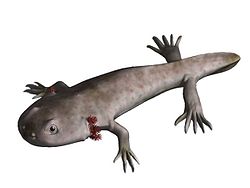
Phyllospondyli
Encyclopedia

Order (biology)
In scientific classification used in biology, the order is# a taxonomic rank used in the classification of organisms. Other well-known ranks are life, domain, kingdom, phylum, class, family, genus, and species, with order fitting in between class and family...
on the basis if their vertebrae, which was either consisting of neural arches over an otherwise unossified notocord or consisting of thin-walled, ring-shaped intercentra topped by the neural arch. The name pyllospondily is from Greek
Greek language
Greek is an independent branch of the Indo-European family of languages. Native to the southern Balkans, it has the longest documented history of any Indo-European language, spanning 34 centuries of written records. Its writing system has been the Greek alphabet for the majority of its history;...
, "leaf vertebrae".
While the group originally was based on the shape of the vertebrae, common in older classification of labyrinthodonts, several families was at times assigned to it based on skull characters. All members were more or less salamander
Salamander
Salamander is a common name of approximately 500 species of amphibians. They are typically characterized by a superficially lizard-like appearance, with their slender bodies, short noses, and long tails. All known fossils and extinct species fall under the order Caudata, while sometimes the extant...
-like in body outline, with weak, poorly ossified limbs, four fingers to the hand and a more or less round skull
Skull
The skull is a bony structure in the head of many animals that supports the structures of the face and forms a cavity for the brain.The skull is composed of two parts: the cranium and the mandible. A skull without a mandible is only a cranium. Animals that have skulls are called craniates...
when seen from above. Remains of larval gill
Gill
A gill is a respiratory organ found in many aquatic organisms that extracts dissolved oxygen from water, afterward excreting carbon dioxide. The gills of some species such as hermit crabs have adapted to allow respiration on land provided they are kept moist...
s were frequently found. What animals was actually assigned to the group varies, Case (1946) gave four families that he confidently assigned to the order: Branchiosauridae
Branchiosaurus
Branchiosaurus is a genus of small, lightly built early prehistoric amphibians. Fossils have been discovered in strata dating from the late Pennsylvanian Epoch to the Permian Period...
(now known to be larval Temnospondyli
Temnospondyli
Temnospondyli is a diverse order of small to giant tetrapods—often considered primitive amphibians—that flourished worldwide during the Carboniferous, Permian, and Triassic periods. A few species continued into the Cretaceous. Fossils have been found on every continent...
), Eugyrinidae (various temnospondyl and anthracosaur groups), Melanerpetontidae and Microbatrachidae (now abandoned). The group as a whole seem to have been a wastebasket taxon for various small, poorly ossified and/or larval fossils, the families once ascribed to it largely being constructed from similar animals found in different parts of the world.

